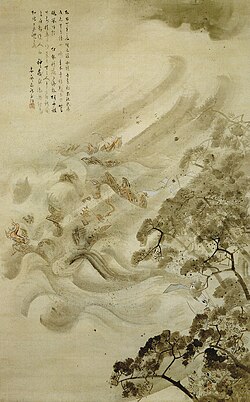Kamikaze (typhoon)
This article needs additional citations for verification. (August 2011) |
The Kamikaze (神風, Japanese for divine wind), were two winds or storms that are said to have saved Japan from two Mongol fleets under Kublai Khan. These fleets attacked Japan in 1274 and again in 1281. Due to growth of Zen buddhism among Samurai at the time, these were the first events where the typhoons were described as "divine wind" as much by their timing as by their force.

History
The latter fleet, composed of "more than four thousand ships bearing nearly 140,000 men"[1] is said to have been the largest attempted naval invasion in history whose scale was only recently eclipsed in modern times by the D-Day invasion of allied forces into Normandy in 1944. According to James McClain, "On each of those two occasions the Mongols gained a toehold on Japanese soil, but then kamikaze, a "divine wind", supposedly stirred up by Japan's protective deities, ravaged the invasion fleets and forced the Mongols back to their continental bases." [2]
Events
The first invasion devastated the Japanese. The battle took place on the beaches where the two forces met. The Mongols had several advantages; the Japanese were overwhelmed and began to retreat. Not knowing they had won, the Mongols feared the Japanese were coming back with reinforcements and also retreated, taking the land force on board and putting out to sea at nightfall to avoid being marooned by the oncoming typhoon. By daybreak, only a few ships had not set out to sea. Those that had, met their doom at nature's hand.
During the time period between the first and second invasion, the Japanese prudently built two-metre walls to protect themselves from future invaders.
Seven years later, the Mongols returned. Unable to find any suitable landing beaches due to the walls, the fleet stayed afloat for months as they depleted their supplies and searched for an area to land. After months of being exposed to the elements, the fleet was destroyed by a great typhoon. The Japanese called it "kamikaze", and the Mongols never returned.
In myth
In popular Japanese myths at the time, the god Raijin was the god who turned the storms against the Mongols. Other variations say that the god Fūjin or Ryūjin caused the destructive kamikaze.
As metaphor
The name given to the storm, kamikaze, was later used during World War II as nationalist propaganda for suicide attacks by Japanese pilots. The metaphor, difficult to translate (as in any from another language), meant that the pilots were to be the "Divine Wind" that would again sweep the enemy from the seas. This use of kamikaze has come to be the common meaning of the word in English.
See also
Notes
- ^ McClain 2002. p. 17.
- ^ McClain 2002. p. 17.
References
- McClain, James L. (2002). Japan: A Modern History. New York: W.W. Norton & Company. p. 724. ISBN 0-393-04156-5.
